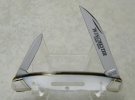- Joined
- Aug 28, 2014
- Messages
- 73
Recently bought the Winchester 2935 in MOP - nice pocket jewelry. The only description of the steel I’ve seen is “high carbon.” As far as patina/staining goes, it is different than for 1095. It reacts as more stainless. i don’t know if all Winchester knives use the same steel but I’ve seen pics of older Winchester knives with lots of patina. Perhaps other owners of the 2935 may like to comment on their experience with the high carbon steel of this model.


